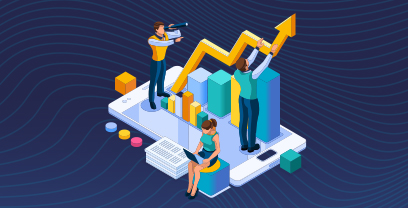Blog »
Webinar Recap: Data as the Driver of Effective Procurement Transformation

by Alex Saric
How do Chief Procurement Officers and their teams leverage digital transformation to take control of their data and better deliver against their strategic objectives?
In this week’s Procurement Leaders webinar recap, we address leveraging the tremendous power of data with Alex Saric, Ivalua’s Chief Marketing Officer and Johan Duba, CTO of Finance at Booz Allen Hamilton.
During this session, the panel answered questions surrounding data as a driver of sustainable value, continuity, and transparency and how data can fuel digital transformation.
Worth a watch: Webinar replay here.
Johan, can you give us a bit of background on the digital transformation journey at Booz Allen and the role of data?
Data is central to successful digital transformation to relay real-time information and greater visibility into operations and resource allocation. We’ve always been focused on ensuring that we have high-quality data that’s accessible and secure. Our commitment to data-driven insights and action oriented outcomes have energized our team to adopt a single platform with a unified data model.
Alex, how important was data during and after the pandemic? What role did data play on a day-to-day basis?
Dramatic supply and demand shifts during the pandemic prioritized the need for data accuracy to solve short and long term supply chain challenges. Data builds the bridge between your own internal supply chain visibility and the information you provide to your stakeholders. Having visibility into where your transactions are within the walls of your organization, whether it’s in a workflow or through the process, is becoming absolutely critical to move through the supply chain process as quickly as possible.
So, then we must ask ourselves, how can you partner with your suppliers to leverage this insightful data? Reaching those key suppliers, accurately assessing inventory, and making that data visible to stakeholders via a high level of integration is imperative for successful supply chain forecasting.
We don’t want processes to keep us from moving up the value chain and we see the importance of partnering with our suppliers to provide a high level of visibility that our stakeholders are demanding.
Alex, how did organizations respond to pandemic supply chain issues? Can you elaborate on the importance of building a solid data foundation?
The pandemic was another wake-up call to the importance of getting your data house in order to support timely, informed decision-making. In the early days of the pandemic, organizations struggled to assess their exposure to Wuhan, which mostly resided in the sub-tier. They then scrambled to identify new sources of supply and qualify those suppliers quickly. Now companies are struggling to assess the ESG performance of their supply chains. Tomorrow the requirement will be something else.
Establishing a sound foundation today will provide the information you need and allow you to layer and capture more information as requirements evolve. If you don’t prepare accordingly, you may exacerbate pre-existing issues and create future roadblocks.
There are a few key elements necessary to build this solid First, take a look at the data you already have in the organization and the backend systems. There are opportunities to leverage Master Data Management integrated with spend management suites to fix existing issues in backend systems and unify enterprise-wide data.
Then look at generating quality data in the source-to-pay process. This includes ensuring you have a single supplier record across stages to enable 360 degree visibility and simplify complimenting internally generated data with supplier-provided and 3rd party sources. Timeliness is also important. You want systems where new data and activity is visible in real time, not based on batch updates.
Lastly, consider accessibility. Users should be able to access data wherever they are in the process. Too few companies plan this right – they often jump on their immediate needs but then exacerbate the problem or create challenges for the future.
We’ve established getting our data foundations right. What do you think is a realistic payback period for such an investment from the date you start the development?
At Ivalua, we really like to emphasize that your digital transformation is a journey, where we can establish some elements upfront so that you can start driving value very quickly as you work on more advanced components, activating more modules, processes or geographies.
We encourage our customers to start with an “out of the box” approach whenever possible. Offering kickstart packages, you can mobilize and deploy sourcing or contract management in less than four weeks. Within a few months, you can often get a significant ROI in the system and then start to expand the scope with more processes without disrupting your bottom line. Once you’ve managed to get all your spend, and processes in place, you can consider unique configurations in strategic areas to build a competitive advantage.
So why does digital transformation go wrong so often? What causes that problem?
Too often, leaders focus on their immediate needs, selecting and deploying a solution that doesn’t support the full journey. The needs and challenges vary as you progress on your digital transformation journey and need to be considered upfront to avoid hitting obstacles later. Early on, adoption is the top challenge, by users AND suppliers. User adoption is often considered but not suppliers. Keep in mind what actually drives supplier adoption, which is simplicity – no fees, no conditions to accept and flexible connection options, all communicated to suppliers by their customer (not some external call center).
As companies work towards digitizing all spend and improving decision-making they run into different issues. Here it’s really important when you’re looking at Source-to-Pay solutions to scrutinize the little details that make a big difference. A unified data model rather than just an integrated suite. Capabilities for the edge case commodities which may constitute a small percent of spend but often hold significant value.
And later in the process, flexibility becomes a central issue. That’s when leaders begin to understand that standardization is helpful for most processes, but there are exceptions. Versatility is an incredible component to implement when requirements change or your team develops a new concept. Systems need to offer packaged capabilities with the flexibility to modify and propel business innovation.
How can I make sure that I’m working with the right data? When you’re looking at the actual purchases and analyzing top-tier information on suppliers, how are you capturing that data?
If you’re capturing data through a new procurement system, you’re going to be better equipped to classify the data accurately without having to rely on spreadsheets and manual entry.
With the right systems in place, suppliers can enter their data and you can automatically augment that information with third party statistics. You can also filter duplicates directly in the system. Ultimately, you need to trust the data you’re putting in front of stakeholders.
Once you have a set of controls and business processes, you’re onboarding suppliers, cleaning supplier data and catalogs catalogs, you can simultaneously link your contracts to your P2P system and then let the magic happen from there with an integrated platform.
We talked about seamless information flows across procurement in business. Where do you see opportunities for organizations to take the next step?
As we look at procurement at Booz Allen, we’re continuing to become more strategic to properly examine other areas of value beyond cost reductions and efficiencies. There are a number of industry-specific integrations within our platform that empower our customers to design their own solutions. If you don’t establish the right fundamentals, you can’t create a holistic approach to your data.
At Ivalua, we’ve built a platform that is focused on procurement but also very extensible beyond that function. As procurement becomes more strategic, it needs to engage and support more business processes. The specific opportunities vary greatly from one customer to the next, based on the industry and organization. If you engage the business, you are sure to identify opportunities.
2022 Data Outlook
As we look to 2022 and beyond, we can’t be sure how priorities will change, but we know that we’ll increasingly require more data and more actionable insights to respond effectively.
Thank you to our webinar moderator Steve Hall, Product Manager, Partnership Products at Procurement Leaders.

Alex Saric
Chief Marketing Officer
Alex has spent over 15 years of his career evangelizing Spend Management, shaping its evolution and working closely with hundreds of customers to support their Digital Transformation journeys. As CMO at Ivalua, Alex leads overall marketing strategy and thought leadership programs. Alex also spent 12 years at Ariba, first building and running the spend analytics business as General Manager. He then built and led Ariba’s international marketing team until successful acquisition by SAP, transitioning to lead business network marketing globally. Earlier, Alex was a founding member of Zeborg (acquired by Emptoris)where he developed vertical Procurement applications. He began his career in the U.S. Cavalry, leading tank and scout platoons through 2 combat deployments. Alex holds a B.S. in Economics from the U.S. Military Academy at West Point and an international M.B.A. from INSEAD.
You can connect with Alex on Linkedin




